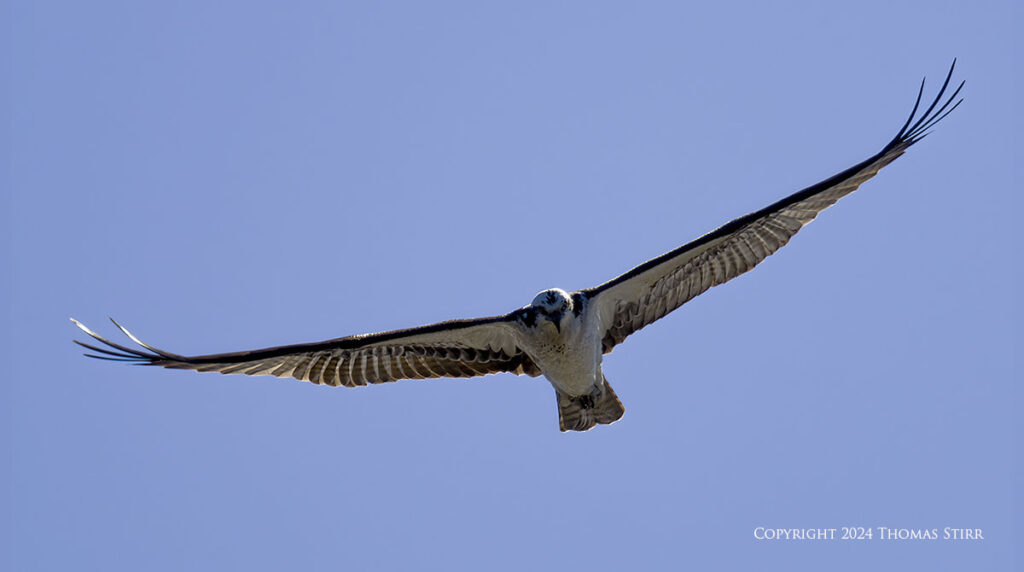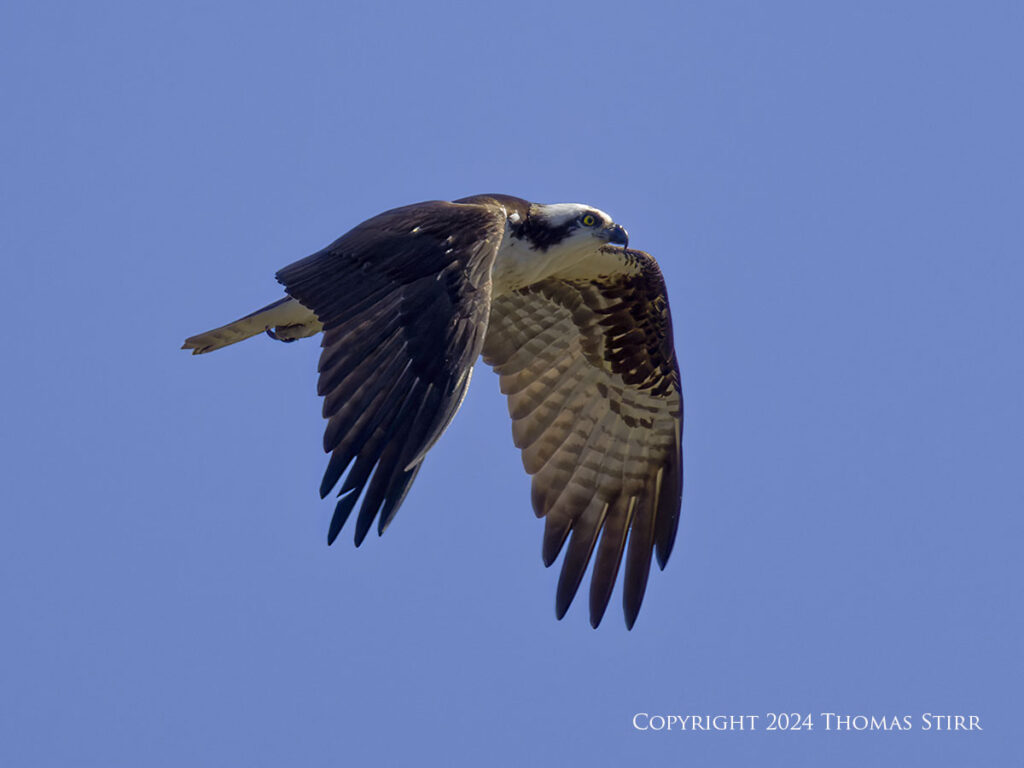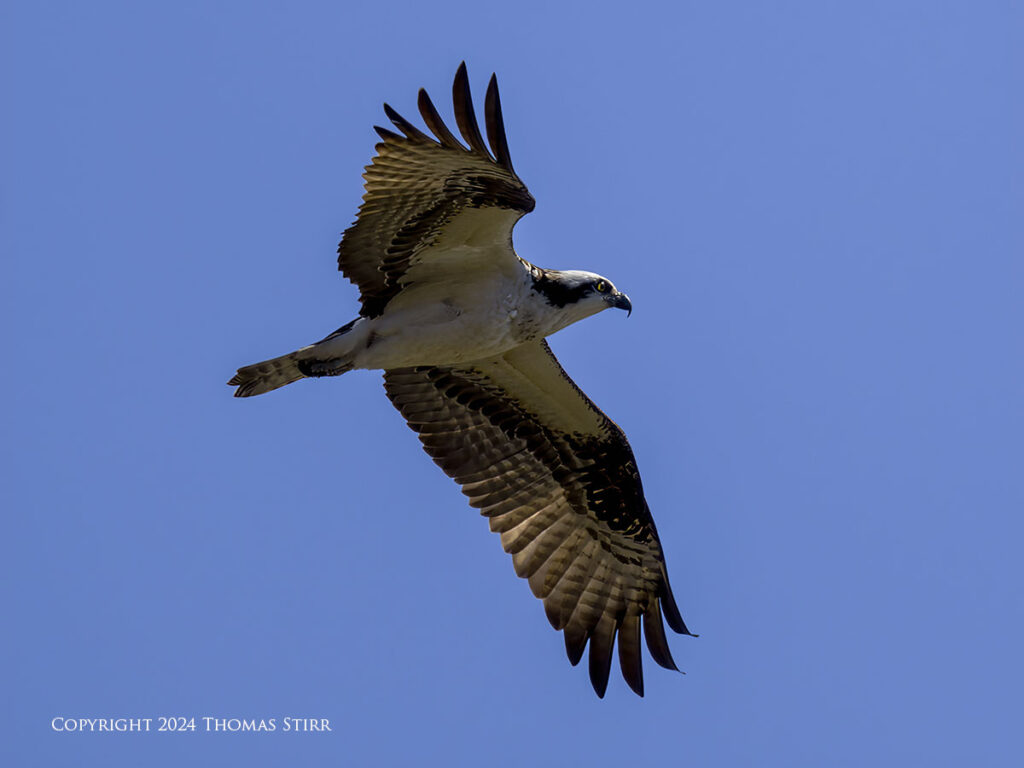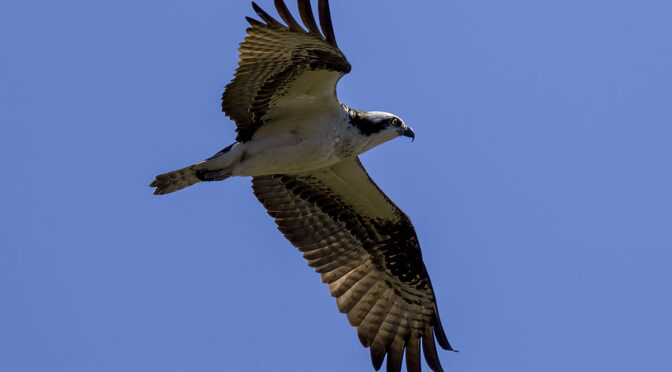During a couple of recent visits to Hendrie Valley I’ve had the chance to photograph an osprey at a distance, flying around the pond area.
These were ideal, real-life opportunities to see how the M.Zuiko 150-600 mm f/5-6.3 IS zoom would perform capturing a medium sized bird in flight at distances of at least 50 metres (~164 feet) from my shooting position.
As you review the images and the EXIF data you can be on watch for some photographs captured using an M.Zuiko MC-14. One of these photographs captured an osprey at a subject distance of 130.2 metres (~427 feet) using a focal length of 840 mm (efov 1680 mm).
We’ll end the article with some silly attempts to photograph an osprey in flight that was more than 200 metres (~655 feet) away. As is my standard practice, all images were captured handheld, without any tracking aids like a red dot sight.
NOTE: Click on images to enlarge.

Our first sample image was captured at a distance of 69.5 metres (~228 feet) using a focal length of 600 mm, efov 1200 mm.
We’ll note the subject distance and focal length used for subsequent photographs.

Subject distance 66.8 metres (~ 219 feet), focal length 600 mm, efov 1200 mm.

Subject distance 72,4 metres (~ 237 feet), focal length 600 mm, efov 1200 mm.

Subject distance 132.1 metres (~ 433 feet), focal length 669 mm efov 1338 mm.

Subject distance 63 metres (~ 207 feet), focal length 600 mm, efov 1200 mm.

Subject distance 130.2 metres (~ 427 feet), focal length 840 mm, efov 1680 mm.

Subject distance 143.3 metres (~ 470 feet), focal length 600 mm, efov 1200 mm.

Subject distance 134.2 metres (~ 440 feet), focal length 669 mm, efov 1338 mm.

Subject distance 54.1 metres (~ 177 feet), focal length 373 mm, efov 746 mm.

Subject distance 66 metres (~ 217 feet), focal length 600 mm, efov 1200mm.

Subject distance 58.9 metres (~193 feet), focal length 600 mm, efov 1200 mm.

Subject distance 65.5 metres (~ 215 feet), focal length 600 mm, efov 1200 mm.

Subject distance 62.8 metres (~ 206 feet), focal length 600 mm, efov 1200 mm.
Let’s move on to some severe crops…
Now let’s have a look at some photographs that I typically wouldn’t have captured due to the distance away from my shooting position. I captured these images specifically for an article of this nature… just to see what would happen.

Subject distance 150.4 metres (~ 494 feet), focal length 600 mm, efov 1200 mm. We can see that Bird Detection AI Subject Tracking was able to grab focus on the osprey while it was in amongst some trees. Below is a severe crop.

This cropped image is only 1753 pixels on the width. You can toggle back-and-forth with the image above to get an idea of the extent of this severe crop.

Subject distance 144 metres (~ 472 feet), focal length 600 mm, efov 1200mm.

Above is our second example of a severe crop.
Let’s end this article with some silly stuff. What follows are three examples of attempting to photograph ospreys that were more than 200 metres away from my shooting position.

Subject distance 203.1 metres (~ 666 feet), focal length 600 mm, efov 1200 mm.

Above is a severe crop done from the previous image. This crop is only 1423 pixels on the width.

Subject distance 202 metres (~ 663 feet), focal length 600 mm, efov 1200 mm.

The crop above is our most severe in this article… a 100% crop or 1200 pixels on the width.

The image above is a 1519 pixel severe crop from our most distant osprey image capture… 210.8 metres (~ 692 feet). A focal length of 600 mm (efov 1200 mm) was used.
I would much rather self-discover what my camera gear is capable of creating by doing this kind of in-field testing. This enables me to go out in the field with a good assessment of my current limitations as a photographer… and how far I can push my camera equipment.
Technical Note
Photographs were captured handheld with the camera equipment noted in the EXIF data. All images were created from RAW using my standard process. I used a combination of Pro Capture L and Bird Detection AI Subject Tracking. I used a single, small AF point, with a frame rate of 18 using continuous auto-focus. My Pre-Shutter Frames were set to 10 and my Frame Limiter was turned off. This is the 1,376 article published on this website since its original inception in 2015.
How you can help keep this site advertising free
My intent is to keep this photography blog advertising free. If you enjoyed this article and/or my website and would like to support my work, you can purchase an eBook, or make a donation through PayPal. Both are most appreciated.
Sometimes all we need as photographers is a bit of inspiration. We hope you can find some of that inside Finding Visual Expression II.
Finding Visual Expression II is available for download for an investment of $11.99 CDN. The best viewing experience of this eBook will be at 100% using Adobe Acrobat Reader.
You may be interested in all of the 30 concepts covered in both of these related eBooks. If so, you may want to also consider Finding Visual Expression.
Finding Visual Expression is available for download for an investment of $11.99 Cdn. The best viewing experience of this eBook will be at 100% using Adobe Acrobat Reader.
Our other eBooks include Images of Ireland, New Zealand Tip-to-Tip, Nikon 1: The Little Camera That Could, Desert & Mountain Memories, Images of Greece, Nova Scotia Photography Tour, and a business leadership parable… Balancing Eggs.
If you click on the Donate button below you will find that there are three donation options: $7.50, $10.00 and $20.00. All are in Canadian funds. Plus, you can choose a different amount if you want. You can also increase your donation amount to help offset our costs associated with accepting your donation through PayPal. An ongoing, monthly contribution to support our work can also be done through the PayPal Donate button below.
You can make your donation through your PayPal account, or by using a number of credit card options.
Word of mouth is the best form of endorsement. If you like our website please let your friends and associates know about our work. Linking to this site or to specific articles is allowed with proper acknowledgement. Reproducing articles, or any of the images contained in them, on another website or in any social media posting is a Copyright infringement.
Article and images are Copyright 2024 Thomas Stirr. All rights reserved. No use, duplication or adaptation of any kind is allowed without written consent. If you see this article reproduced anywhere else it is an unauthorized and illegal use. Posting comments on offending websites and calling out individuals who steal intellectual property is always appreciated!




Thomas,
Your shots are amazing!
I have a C1 setting for BIF with my EM1X. I use the 300mm prime and often with my 1.4X. My exposure settings are 1/1600, ISO on auto and my f stop at 8 ( to help on depth of field). I have also set my exposure to be 1.3 stops over so I see definition underneath the bird and to compensate for the sky. How do you see the underside of the bird so well? Also where do you have your exposure location (spot or center-weighted)?
Hi David,
Unlike many folks when they photograph birds I typically use matrix metering. I use 1/1600 for birds in flight, with a combination of Bird Detection AI Subject Tracking and Pro Capture L. I use a single, small AF point for all of my photography. For birds, dragonflies etc. taking flight I use Pro Capture H at 60 fps with the first frame locking focus and exposure, and a shutter speed of 1/2500. I also use Auto-ISO, but shoot all of my lenses wide open.
I use DxO PhotoLab as my initial RAW processor. I use DxO Smart Lighting Spot adjustment function to help me balance out my exposures. This works quite well and I use it with all of my images, regardless of subject matter.
I have a pair of E-M1X cameras. C1 through C4 on my E-M1X camera for birding all are set to various settings for bird photography depending what the subject bird is doing and how I want to capture the image.
I do adjust exposure compensation and/or metering depending on the specific lighting and subject bird.
Tom
Thanks for your prompt response. You have given me ideas to try in the field!
Carry on!
Hi David,
Experimentation is a cornerstone of growth… whether a new idea works or not!
Tom
Thomas,
Do you often tweak the brightness/exposure underneath a raptor with your DxO photolab?
Hi David,
After I’ve applied my custom pre-set in DxO PhotoLab I click on Spot Weighted in the DxO Smart Lighting adjustment area. Then click on ‘Tool’ and draw a box on a portion of the osprey. You can adjust the strength of the adjustment. Typically to lighten the belly and get better overall exposure balance I would draw a rectangle on a dark portion of the bird’s wing. To get the amount of adjustment I want takes a bit of experimenting with box size, position and strength of the Smart Lighting function.
Tom
Yep. I tweaked my BIF settings and took it for a spin today. Still practicing having not done alot with Pro Capture.
Hi David,
Waiting until a bird has done the action you were anticipating before fully depressing the shutter release will likely feel counterintuitive at first. Have fun with it.
Tom
Awesome article as usual, and amazing photography. I sure would like to get that lens, oh boy!.
On a side note, I just watched a video on YT, that shows a German site has put forth that the OM1 mk2 has regressed in the auto focus area compared to the OM1 mk1, and also went on the explain that the OM1s have regressed in auto focus compared to the EM1X, and the EM1 mk3. Interesting. Glad I/we stuck with ol faithful.
Randy
Hi Randy,
I’m glad you enjoyed the images of the ospreys in flight. It was quite enjoyable capturing these images as the birds were the first of the spring season for us in this area.
It can take quite a long time to really learn how to use a particular camera body. I’d get my salt shaker out when reading comments about auto focus regression with the OM-1 bodies. In my mind the more probable cause is a lack of familiarity with the newer cameras and/or an insufficient skill level using the equipment.
My initial E-M1X will be 5 years old next month and I love it more now that I did a few years back. Maybe I’m a slow learner but it took me a couple of years to properly understand how to use it given my shooting style.
Tom
From what I have seen is that the OM1 mk2 is an amazing camera. It is the first with Live graduated neutral density filter. That’s amazing. If there was no such thing as an EM1X, I would be running dual OM1 mk2’s with the grip on each cam.
Yep, I’m running about 5 years too with my X’s. It has gotten to the point where I don’t even think when using due to my total feeling of the camera as an extension of me. This takes years and lots of mistakes…
Also, is the satisfaction of knowing just how to process the files from the camera which is also years of learning.
I’m an old dog who would not relish the thought of learning a new camera.
Cheers!
Hi Randy,
Your experiences mirror my own. Shooting with my pair of E-M1X bodies is a Zen-like experience. I know exactly what to expect from the cameras. As you said it does take years to develop that level of understanding, and dare I say kinship with a camera.
Tom